Looking to transform your kitchen into a stylish and functional space? A DIY breakfast bar might be the perfect addition you’ve been missing. We’ve gathered some of the most inspiring and practical breakfast bar ideas that won’t expensive or require professional help.
Whether you’re working with a small apartment kitchen or a spacious cooking area, breakfast bars offer versatile answers for casual dining, additional workspace, or a spot to enjoy your morning coffee. From repurposed furniture to clever wall-mounted designs, these DIY projects can be customized to match your existing décor and spatial constraints. Let’s explore how you can create this popular kitchen feature with materials you might already have or can easily source.
10 Space-Saving DIY Breakfast Bar Ideas for Small Kitchens
1. Wall-Mounted Fold-Down Bar
Wall-mounted fold-down breakfast bars offer the ultimate space-saving solution for tiny kitchens. These clever installations function like a Murphy bed for your dining space, folding flat against the wall when not in use. You’ll need just a few materials: a sturdy piece of wood for the tabletop, heavy-duty hinges, and mounting brackets. Remember to secure it to wall studs for proper support, ensuring it can withstand daily use and accommodate multiple place settings.
2. Repurposed Window Sill Extension
Transform your kitchen window sill into a charming breakfast nook by extending its depth with a matching countertop material. This option takes advantage of often unused space while providing natural light during morning meals. Your window sill extension requires minimal materials yet creates a dedicated spot for coffee or quick bites. Secure the extension with L-brackets underneath for stability and consider adding bar stools that can be tucked completely under when not in use.
3. Rolling Cart Conversion
Converting a rolling kitchen cart into a mobile breakfast bar gives you flexibility in small spaces. These versatile carts can serve multiple purposes throughout the day—breakfast bar in the morning, food prep station at dinner time, and tucked away when extra floor space is needed. Many carts come with built-in storage underneath for kitchen essentials, further maximizing your limited space. Look for carts with locking wheels to prevent unwanted movement during use.
4. Half-Wall Countertop Addition
Adding a countertop to an existing half-wall or partition creates a natural division while providing a dedicated eating space. This solution works perfectly between kitchens and living areas in open-concept apartments or small homes. Half-wall breakfast bars require no additional floor space yet establish a defined dining area. Use the same countertop material as your kitchen for a cohesive look or create contrast with a complementary material.
5. Slim Console Table Transformation
Narrow console tables can be repurposed into space-efficient breakfast bars that sit flush against walls or behind sofas. Their slim profile typically measures just 10-12 inches deep, making them perfect for tight spaces while still providing enough room for place settings. Select a console table with the right height for comfortable seating or modify the legs to achieve your desired height. This option offers a convenient eating space without dominating your limited square footage.
6. Corner Breakfast Nook
Utilizing corner spaces efficiently transforms often wasted areas into cozy breakfast nooks. Corner installations maximize seating capacity while minimizing footprint in square footage. You can build a simple corner breakfast bar using two pieces of countertop material joined at a 90-degree angle, supported by wall brackets or a small cabinet base. This arrangement typically accommodates 2-3 people comfortably in a space that might otherwise go unused.
7. Extendable Counter Flap
Installing a hinged counter extension to your existing kitchen countertop provides an eat-in area that appears only when needed. This pull-up or swing-out solution functions like a table leaf for your counter space. Supporting brackets that fold down or slide out ensure stability during use while allowing complete retraction when extra floor space is preferred. This modification can usually be accomplished in a weekend with basic tools and hardware.
8. Floating Shelf Bar
Creating a simple floating shelf at bar height delivers a minimalist breakfast spot without bulky supports. Floating shelves maintain open floor space beneath, contributing to a more spacious feel in tight kitchens. Mount your shelf securely to wall studs using heavy-duty brackets capable of supporting weight from both the countertop and people leaning on it. This streamlined option works particularly well in galley kitchens or narrow spaces between appliances.
9. Kitchen Island on Wheels
Compact kitchen islands on casters provide movable breakfast bar functionality that adapts to changing needs. These islands typically measure about 24-30 inches wide, offering sufficient space for dining while remaining maneuverable. The wheels allow you to reposition the island as needed—pull it out for breakfast, push it against a wall for extra floor space, or move it to the center of the kitchen when entertaining. Many models include storage shelves or drawers beneath the countertop.
10. Counter-Height Desk Conversion
Repurposing a slim desk as a breakfast bar brings unexpected functionality to small kitchens or studio apartments. Counter-height desks typically measure 36 inches tall, ideal for comfortable dining with standard bar stools. Choose a desk with a depth of 18-24 inches to provide adequate dining space without protruding too far into the room. This dual-purpose furniture can serve as both a breakfast spot and a work-from-home station, making it perfect for contemporary small-space living.
Transforming Kitchen Islands into Stylish Breakfast Bars
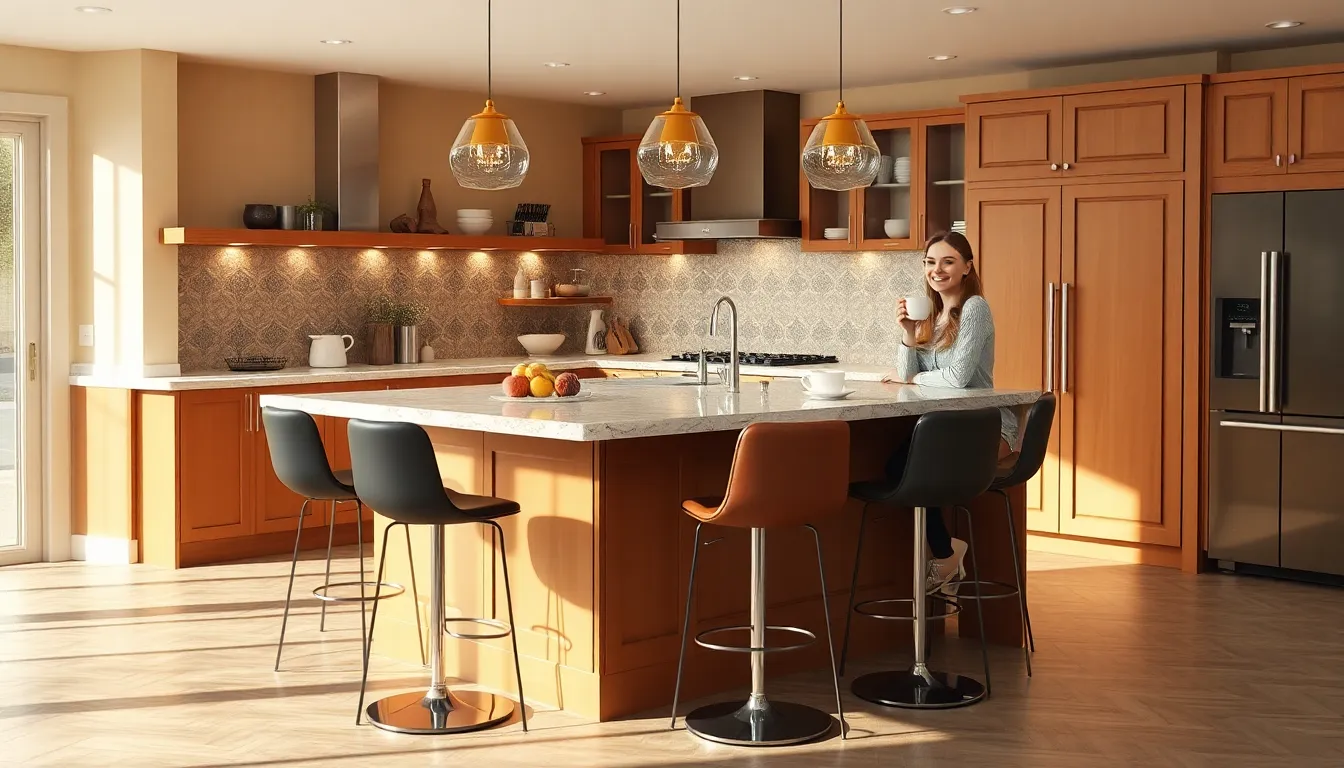
If you already have a kitchen island, transforming it into a breakfast bar is one of the most straightforward and impactful kitchen upgrades you can make. This conversion can dramatically enhance both the functionality and aesthetic appeal of your space without major construction.
Use Existing Structure
Converting an existing kitchen island into a breakfast bar starts with utilizing what you already have. Add a raised counter or custom overhang to create designated seating space separate from your main work area. The transformation requires minimal structural changes while significantly expanding your kitchen’s functionality. Installing a countertop extension that reaches beyond the island’s edge establishes a comfortable spot for family meals or morning coffee. Enhance the visual appeal of your new breakfast bar with thoughtful details like a coordinating backsplash, statement lighting fixtures, or decorative tiles that complement your kitchen’s style.
Adding Bar Stools to Existing Islands
Height considerations play a crucial role when adding bar stools to your kitchen island. The standard counter height for comfortable seating typically measures around 42 inches, allowing adequate legroom for guests and family members. Measure your existing island carefully before purchasing stools to ensure proper proportions and ergonomics.
Selecting the right bar stools dramatically impacts both comfort and style in your breakfast bar area. Choose designs that complement your kitchen’s existing color scheme and aesthetic to create a cohesive look throughout the space. Materials like wood, metal, and upholstered options each bring different characteristics to your design – wood adds warmth, metal provides industrial flair, while upholstery introduces comfort and color opportunities.
Installing Overhanging Countertops
A proper support system ensures your overhanging countertop remains stable and safe for daily use. Metal brackets installed underneath the extended portion prevent sagging and provide essential structural integrity to your breakfast bar. Position these supports approximately every 24 inches along the overhang for optimal weight distribution and durability.
Safety precautions cannot be overlooked when installing your new countertop extension. Apply construction adhesive between the countertop and support structure to create a strong bond that prevents shifting. Secure the countertop firmly to the brackets with appropriate fasteners, ensuring all connections are tight and stable. This attention to installation details guarantees your breakfast bar will withstand years of daily use while maintaining its appearance and functionality.
Repurposing Old Furniture for Custom Breakfast Bars
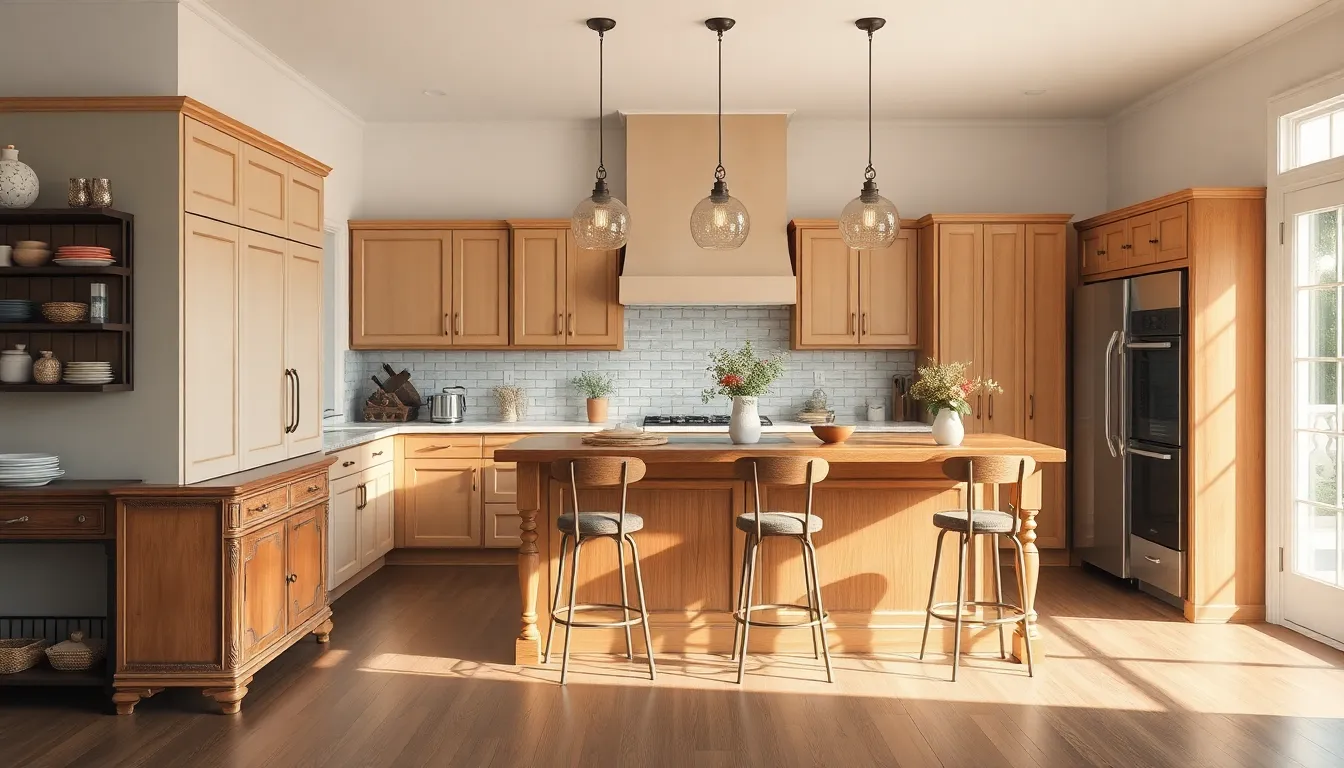
Creating a breakfast bar doesn’t always require buying new materials or hiring contractors. With a bit of creativity, you can transform existing furniture pieces into functional, stylish breakfast bars that add character to your kitchen.
Converting Vintage Consoles
Vintage console tables offer excellent potential for breakfast bar conversions. To create this transformation, simply add a wooden or granite countertop to your console table, ensuring it’s at the right height for comfortable seating. The natural structure of console tables—with their slim profiles and sturdy legs—makes them ideal candidates for kitchen bar areas. Enhance your newly created breakfast spot with complementary bar stools or chairs that match your kitchen’s aesthetic. Adding pendant lights or decorative fixtures above the bar creates a focused dining area while highlighting your creative repurposing project.
Upcycling Bookshelves and Cabinets
Bookshelves and old cabinets can find new life as innovative breakfast bars in your kitchen space. Large bookshelves transform easily by attaching a countertop or wooden plank across the top surface, creating an instant bar with built-in storage underneath. Unused kitchen cabinets work wonderfully as breakfast bar bases—simply secure them to a wall for support and add a wooden top that extends to create an overhang for seating. Painting or staining these repurposed pieces helps them blend seamlessly with your existing kitchen decor. The shelving in these converted pieces offers practical storage for everything from cookbooks to coffee mugs, making your breakfast bar as functional as it is attractive.
Wall-Mounted Fold-Down Breakfast Bar Solutions
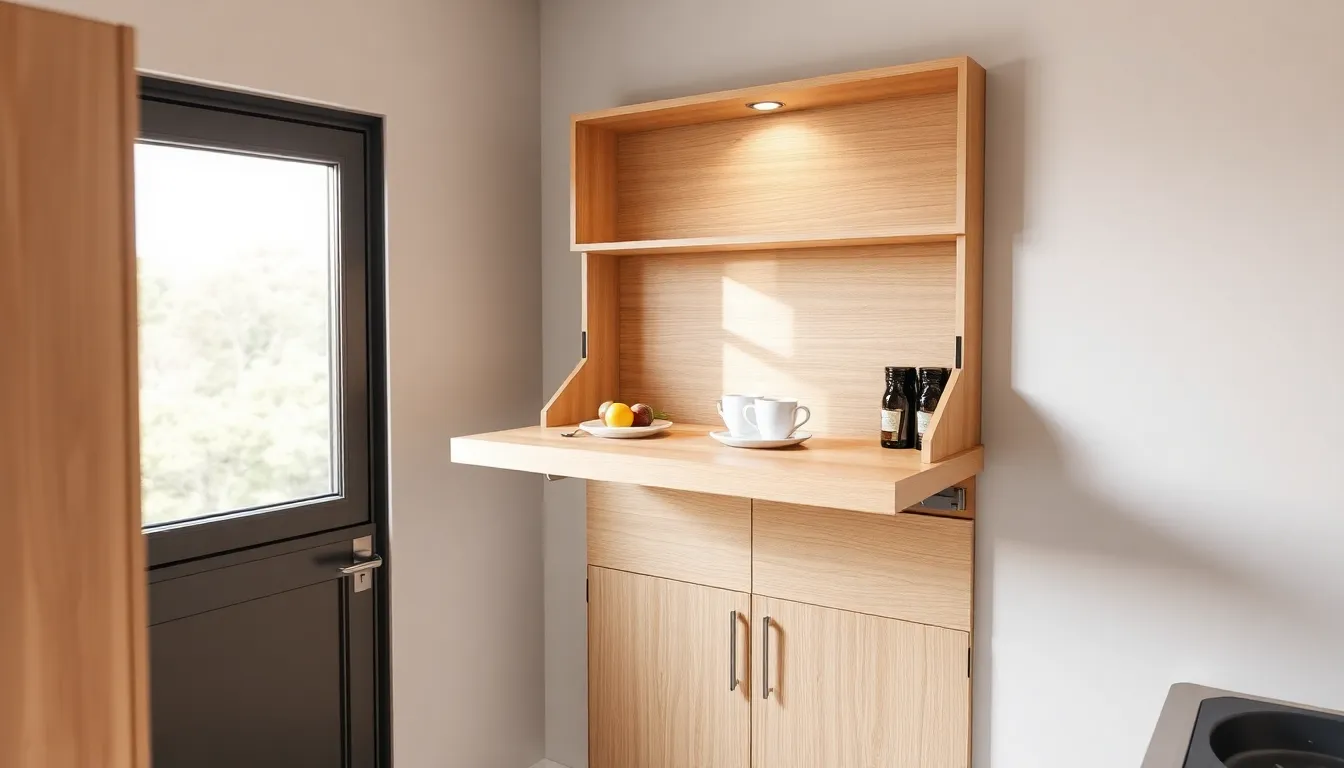
Wall-mounted fold-down breakfast bars offer the perfect space-saving solution for small kitchens, providing functionality without sacrificing precious floor space. These versatile installations can transform even the tightest kitchen into a practical dining area with just a few simple DIY techniques.
Murphy-Style Fold-Down Designs
Murphy-style fold-down breakfast bars operate on the same principle as Murphy beds, cleverly collapsing against the wall when not in use. Installation requires anchoring sturdy brackets directly into wall studs to ensure proper stability and weight support. For optimal durability, use heavy-duty piano hinges or specialized drop-leaf table hardware that can withstand regular folding and unfolding motions. Lightweight countertop materials such as plywood or laminate work best for these applications, reducing stress on the hinges while maintaining functionality.
Mount your breakfast bar at standard counter height (36 inches) or bar height (42 inches) depending on your preference and available space. Adding fold-down support legs provides additional load-bearing capacity for heavier items or leaning elbows. Soft-close hinges prevent slamming and extend the lifespan of your breakfast bar, while hidden storage compartments beneath the folded surface offer convenient storage for placemats, utensils, or table linens.
Remember to limit overhangs to 24 inches or less unless you incorporate vertical support legs. Reinforcing mounting points with proper wall studs or toggle bolts ensures your breakfast bar can safely support daily use without compromising structural integrity.
Window-Sill Conversion Techniques
Window areas present unique opportunities for creating functional breakfast bars through simple conversion techniques. Attach fold-out or pull-out countertop extensions to existing window sills using secure brackets for an instant dining space with a view. Materials like quartz or sealed wood resist moisture effectively, making them ideal choices for window-adjacent installations where condensation might occur.
Create multi-functional window breakfast bars by integrating fold-down trays or sliding panels that expand your workspace while maintaining access to the window. This approach works particularly well in apartments or condos where permanent modifications might be restricted. For extremely narrow window sills, install a wall-mounted ledge directly below the window and pair it with foldable stools that store neatly underneath when not in use.
Match your window-sill breakfast bar materials to existing countertops for a cohesive look, or intentionally choose contrasting finishes like butcher block over marble to create visual interest. Safety remains paramount with any fold-down mechanism, so incorporate childproof locks or magnetic latches to prevent accidental deployment, especially in homes with young children.
Budget-Friendly Breakfast Bar Materials and Options
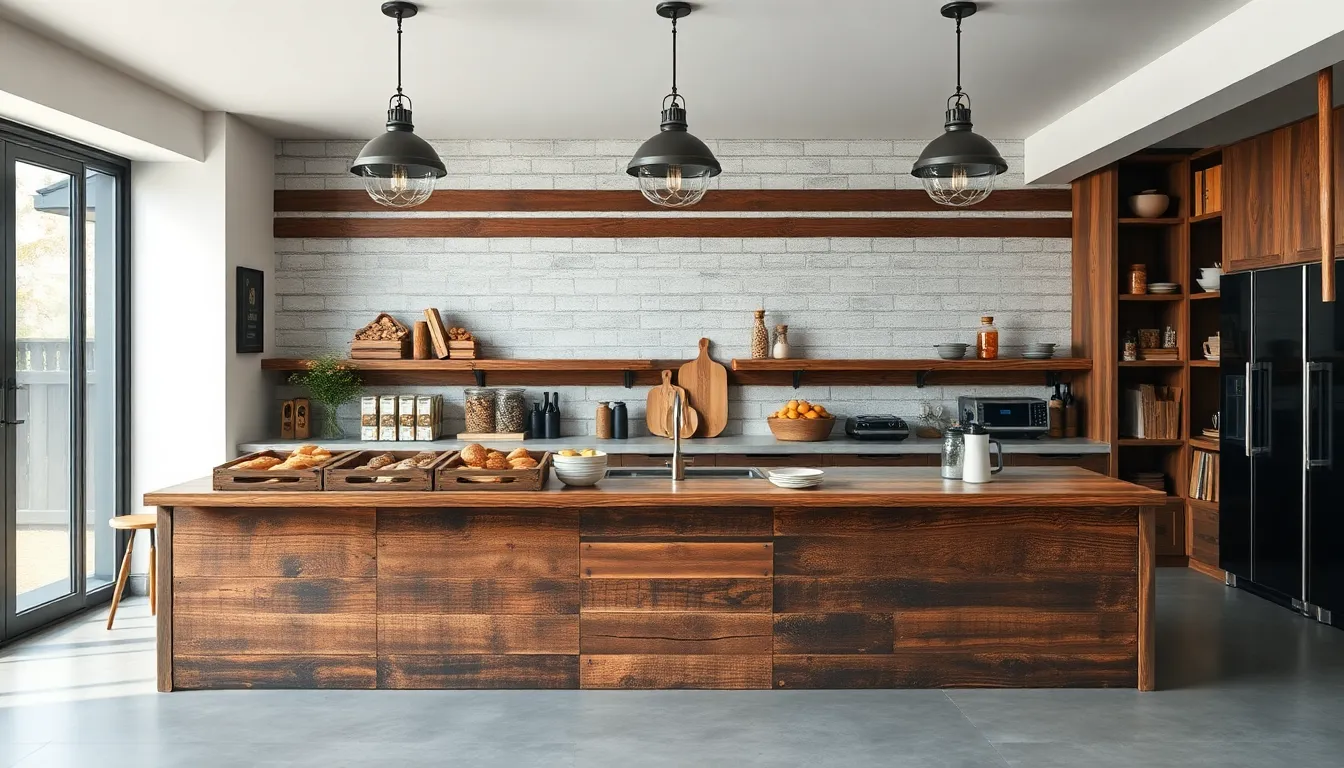
Creating a stylish breakfast bar doesn’t have to expensive. We’ve compiled innovative ways to design functional eating spaces using affordable materials and clever space utilization techniques.
Reclaimed Wood Projects
Reclaimed wood offers an eco-friendly and cost-effective option for breakfast bar construction. Salvaged timber brings unique character and warmth to your kitchen while reducing environmental impact. Old barn boards, shipping pallets, or discarded furniture can be transformed into stunning bar tops with minimal investment. The natural patina and texture of weathered wood creates an instant focal point that complements various kitchen styles. You can seal reclaimed wood with food-safe finishes to ensure durability and ease of cleaning for daily use.
Wooden crates present another versatile reclaimed option, serving both functional and aesthetic purposes. Stacking crates creates tiered displays perfect for organizing breakfast essentials like cereals, pastries, and coffee supplies. This approach combines storage answers with visual interest, maximizing the utility of your breakfast zone. Creative arrangement of different-sized crates allows customization based on your exact storage needs and available space.
Concrete and Industrial Designs
Concrete countertops deliver modern industrial appeal without the premium price tag of natural stone. This versatile material can be customized in various colors and textures to match your existing décor. DIY concrete mixes are readily available at home improvement stores, making this an accessible project for handy homeowners. The durability of concrete ensures your breakfast bar will withstand years of daily use while maintaining its distinctive appearance.
Industrial lighting fixtures complement concrete surfaces perfectly, improving the contemporary aesthetic. Exposed bulbs, metal pendant lights, or repurposed factory fixtures add character while providing essential task lighting. These elements create visual cohesion and reinforce the industrial theme throughout your breakfast area. Sourcing vintage or second-hand industrial fixtures can significantly reduce costs while adding authentic charm to your space.
Beyond materials, smart utilization of existing spaces presents another budget-friendly approach. Converting an underused corner or kitchen nook into a breakfast area requires minimal construction. Wall-mounted or corner tables maximize floor space while creating functional dining areas. Pairing these space-saving answers with repurposed furniture bases transforms overlooked areas into charming breakfast nooks.
For truly economical countertop options, consider laminate or butcher block alternatives to expensive materials. Both provide durability and aesthetic appeal at a fraction of the cost of granite or quartz. Modular components like galvanized trays or tiered servers offer flexibility, allowing easy setup and reconfiguration of your breakfast bar as needs change.
Portable and Rolling Breakfast Bar Carts
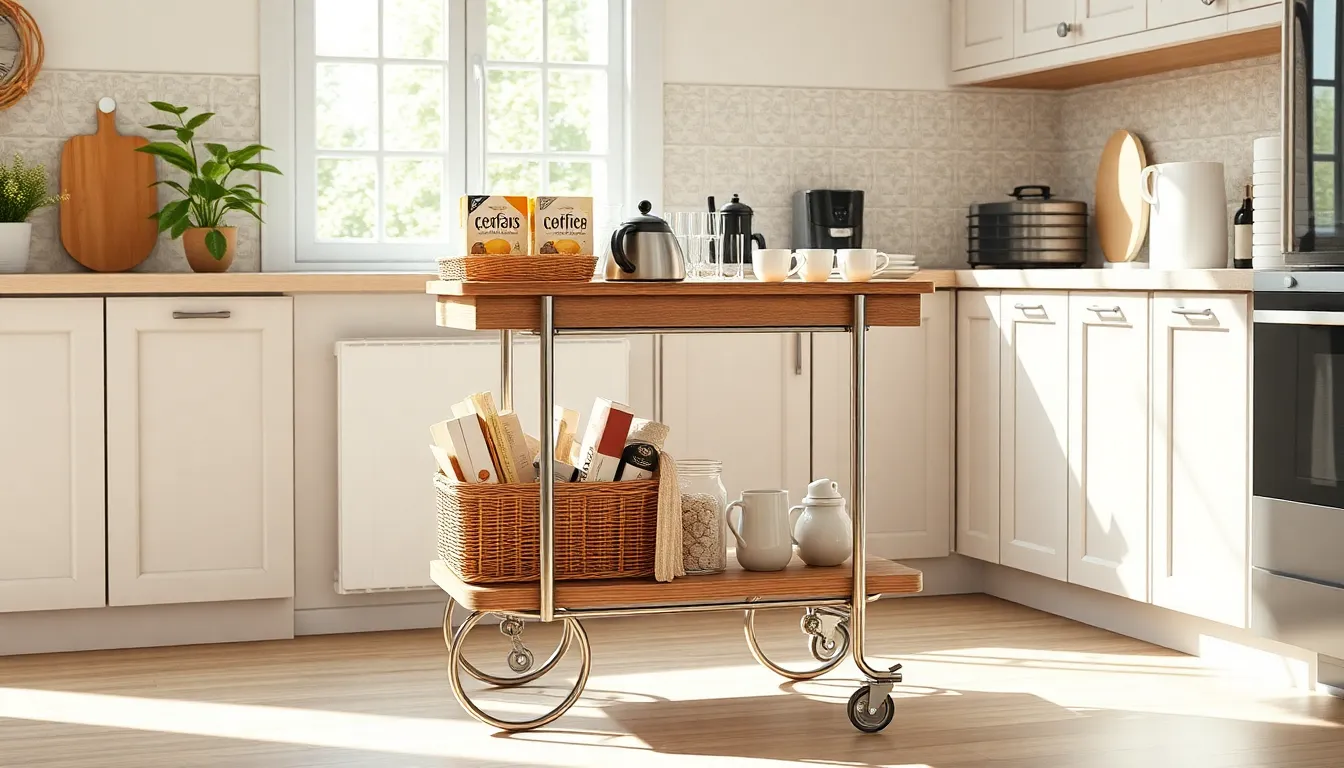
Portable breakfast bar carts offer the perfect solution for kitchens with limited space or for homeowners who love versatility in their dining options. These mobile units combine style and functionality, allowing you to create a dedicated breakfast area that can be repositioned as needed.
Versatility in Design and Function
Rolling breakfast carts excel in adaptability, easily moving from kitchen to dining room or even outdoor spaces when entertaining guests. Their mobility makes them ideal for small apartments where permanent installations aren’t practical. Wood, metal, or repurposed furniture can all serve as excellent materials for constructing these convenient carts. Many homeowners add wheels to existing furniture pieces like narrow console tables or kitchen islands to create custom rolling breakfast stations that match their décor perfectly.
Storage Answers
The best portable breakfast bars incorporate smart storage options that keep essentials organized and accessible. Many designs feature shelves and cabinets specifically sized for breakfast necessities like cereal boxes, coffee supplies, and dishware. Consider adding hooks for hanging mugs, built-in cup holders, or specialized compartments for cutlery to maximize functionality. Rolling carts with drop-leaf extensions provide additional eating space when needed while maintaining a compact footprint when storage is the priority.
Multi-Purpose Serving Stations
Multi-purpose breakfast bars function beyond morning meals, doubling as buffet tables for dinner parties or event servicing stations. These versatile pieces seamlessly transition between different roles throughout the day, making them especially valuable in homes where space is at a premium. Available in countless design styles from sleek modern to charming rustic, these stations can complement any kitchen aesthetic. Many homeowners integrate these serving stations with existing kitchen furniture for a cohesive look, using matching finishes or complementary design elements to create visual harmony.
Collapsible Mobile Options
Collapsible breakfast bars offer the ultimate space-saving solution for occasional use or extremely small kitchens. These lightweight options typically use materials like aluminum, plastic, or thin plywood that maintain durability while keeping weight manageable. Setup and breakdown typically takes just minutes, making these options perfect for weekend brunches or holiday gatherings when extra serving space is temporarily needed. The convenience factor cannot be overstated—when not in use, these collapsible units can be stored in closets, under beds, or behind doors, making them practical additions to apartments or homes where permanent breakfast bars aren’t feasible.
Creating Corner Breakfast Bars to Maximize Unused Space
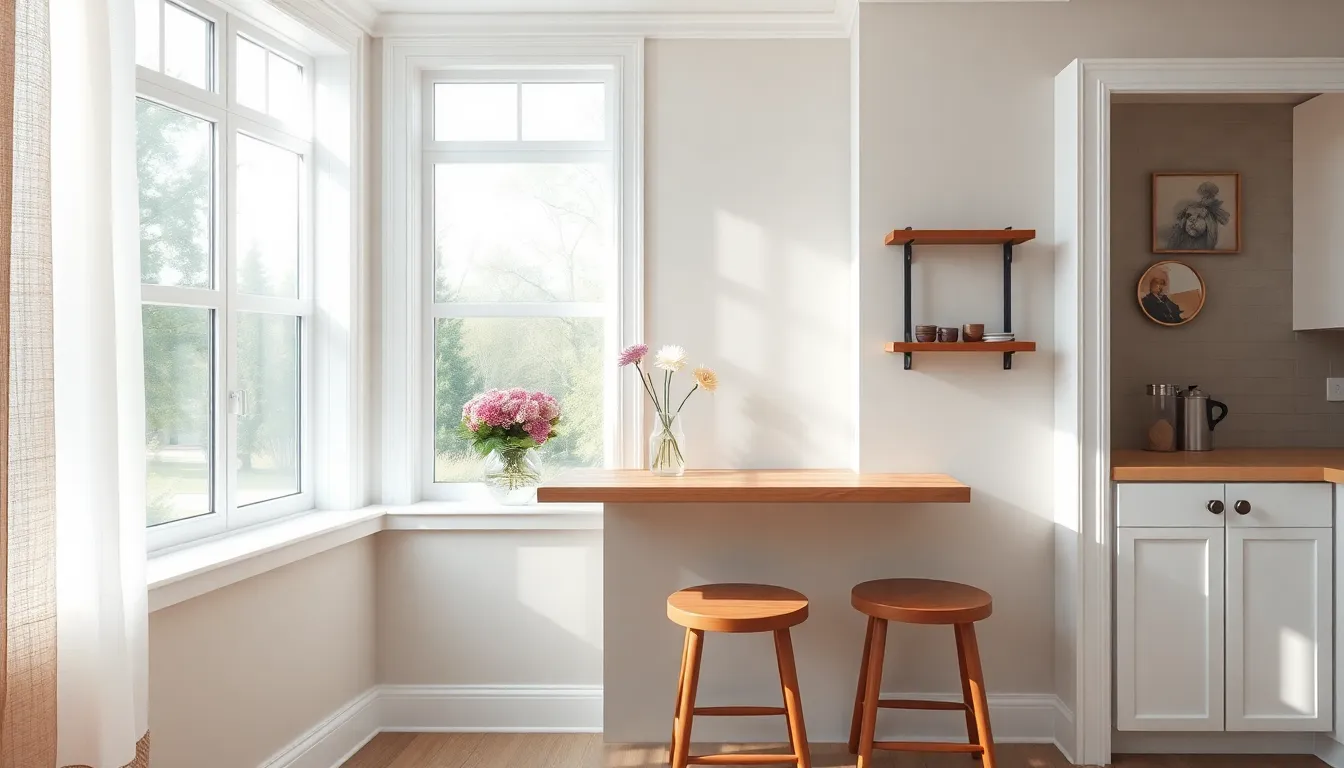
Corners often become wasted space in kitchens, but they actually offer perfect opportunities for creative breakfast bar answers. By thinking strategically about these underutilized areas, you can add both functionality and style to your home without major renovations.
Use Corners
Corner spaces transform beautifully into cozy breakfast nooks with minimal materials and effort. We recommend using sturdy wood pieces or repurposed furniture to create a solid foundation for your corner bar. Simple wall-mounted shelving can be installed at counter height, creating an instant breakfast surface that doesn’t intrude into your walking space. Pair this setup with compact seating options like wall-mounted stools or folding chairs that can accommodate two or more people while maximizing the available space. For added functionality, consider incorporating a corner table design with built-in storage compartments, perfect for keeping utensils, plates, and napkins neatly organized and within reach.
L-Shaped Designs for Awkward Corners
Space-saving L-shaped breakfast bars excel at fitting into tight or awkward corners while offering both ample seating and counter space. These designs work particularly well when extending from existing kitchen countertops, creating a natural flow between cooking and dining areas. You can easily create this look by extending your countertop from a kitchen wall to form an L-shape with a comfortable small dining area. The perpendicular sections provide multiple seating options and make conversations more intimate and captivating. Enhance your L-shaped breakfast bar with accent lighting, particularly under-cabinet fixtures that highlight the area and create a warm, inviting ambiance for morning meals or coffee breaks.
Bay Window Breakfast Nooks
Bay windows present ideal opportunities for creating charming breakfast nooks filled with natural light. Turn these architectural features into functional dining spaces by installing built-in seating or positioning a comfortable window bench beneath the windows. The window sill itself can serve as additional counter space for serving food, displaying decorative items, or holding your morning coffee essentials. For a softer, more intimate atmosphere, hang sheer curtains that filter natural light while maintaining privacy and creating a cozy environment. This approach not only utilizes an often overlooked space but also creates a bright, cheerful spot to start your day with breakfast or enjoy afternoon tea with a view.
Outdoor and Patio DIY Breakfast Bar Ideas

Extending your breakfast bar concept to outdoor spaces creates versatile entertaining areas perfect for morning coffee or evening gatherings. Let’s explore weather-hardy materials and design approaches that seamlessly blend indoor comfort with outdoor enjoyment.
Weather-Resistant Materials
Creating a durable outdoor breakfast bar requires materials specifically designed to withstand nature’s elements. Composite decking stands out as an excellent choice for the structure, with products like Ekodeck offering superior resistance to moisture and harmful UV rays. Concrete countertops deliver both longevity and contemporary appeal, and can be cast using melamine molds to achieve precise, professional-looking edges. For the framework, we recommend using pressure-treated lumber or steel angle brackets that have been properly treated to prevent rust and deterioration over time. Adding a pergola roof provides essential protection from unexpected weather, while string lights create practical illumination for enjoying your breakfast bar after sunset. These material choices ensure your outdoor breakfast bar remains functional and attractive even though rain, sun, and seasonal changes.
Indoor-Outdoor Transitional Designs
Transitional breakfast bar designs effectively bridge the gap between your kitchen and outdoor living spaces. Covered pergolas offer ideal shade answers while maintaining essential airflow, particularly when paired with adjustable-height bar stools that accommodate various users. L-shaped layouts maximize corner spaces brilliantly, allowing for integrated grills and storage options that blend kitchen functionality with bar convenience. Cantilevered bars attach directly to existing structures such as patio columns, creating a seamless extension of your living space while properly distributing weight for structural integrity. Pull-down shades installed on pergolas or gazebos provide instant protection during unexpected weather changes without compromising the open-air feel of your space.
Smart structural elements enhance both functionality and aesthetics in outdoor breakfast bars. Modular storage cabinets incorporated beneath countertops keep utensils and decorative elements organized and accessible. Adjustable stools ensure comfortable seating regardless of counter height variations. Cladding your bar with pre-painted panels in complementary colors like Woodland Grey helps maintain visual cohesion with existing outdoor décor. Waterproof LED strip lighting or suspended string lights create ambiance while providing necessary visibility for evening use.
For a sophisticated touch, apply kitchen-grade finishes such as ceramic tiles or stainless steel accents to achieve a polished, indoor-quality appearance in your outdoor setting. Space-constrained patios benefit from foldable countertop designs or wall-mounted bars that can be retracted when not in use, maximizing functionality without permanently consuming valuable outdoor living space.
Lighting and Decor Elements for Your DIY Breakfast Bar
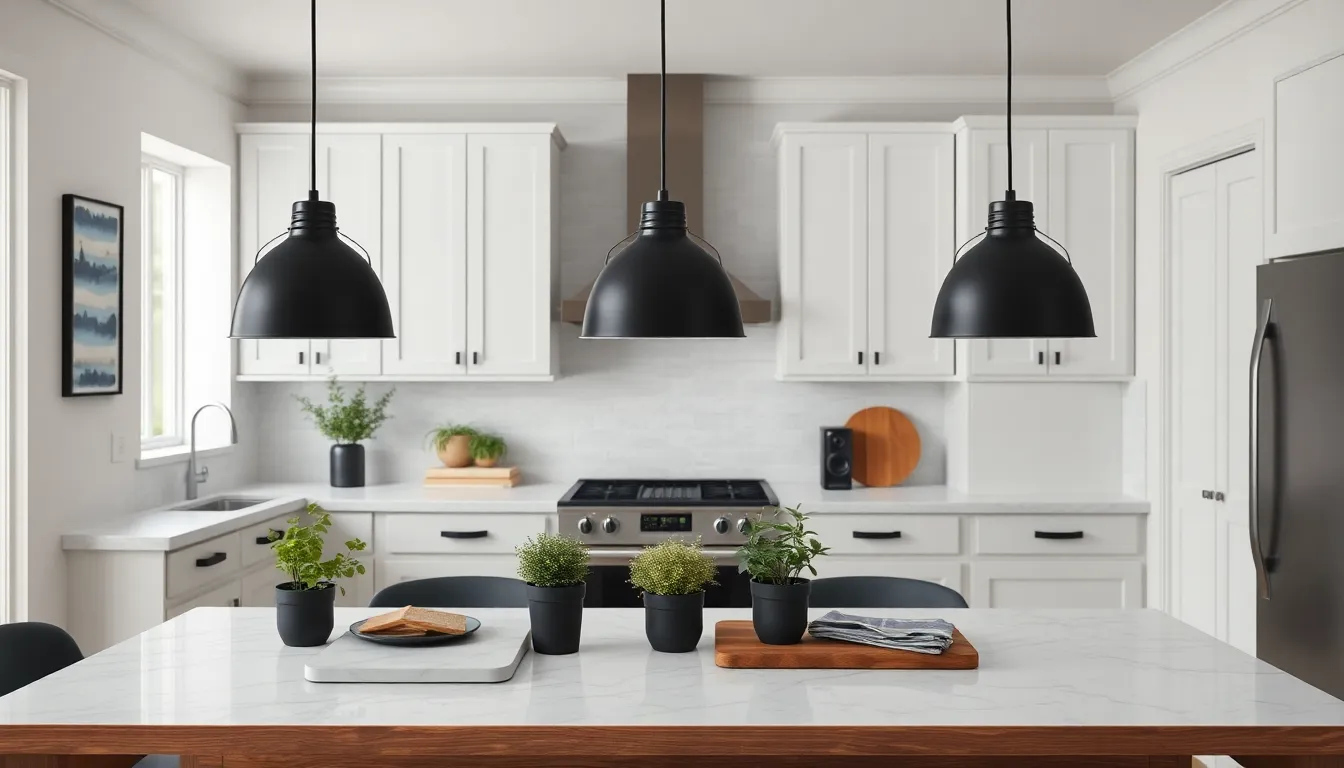
The right lighting and decor can transform your DIY breakfast bar from a simple eating space to a stunning focal point in your kitchen. These elements add both functionality and style, creating an inviting atmosphere for morning coffee or casual meals.
Pendant Lighting Installations
Pendant lights serve as perfect statement pieces above your breakfast bar, providing focused illumination exactly where you need it. Sleek black or metallic fixtures work beautifully with modern design schemes, creating a contemporary look that’s both practical and stylish. For more rustic or farmhouse-inspired kitchens, woven or glass shade pendants add warmth and character while still maintaining that essential task lighting.
When installing pendants, we recommend positioning them 30-36 inches above the counter surface to create optimal lighting without obstructing sightlines across your breakfast bar. Multiple pendants spaced evenly along the length of your bar create a balanced look that enhances the overall aesthetic while ensuring proper illumination for dining and food preparation.
Artful Accents and Decor
Adding carefully selected decor elevates your breakfast bar without creating clutter. Neutral artwork positioned near your breakfast bar creates visual interest while maintaining a clean, sophisticated look. Living elements like small potted herbs or succulent arrangements bring a touch of nature indoors and serve double duty as both decoration and functional kitchen ingredients.
For a luxurious hotel-inspired atmosphere, consider incorporating marble surfaces or navy-blue-and-gold accent pieces. These high-end touches can be introduced through small details such as marble serving boards, metallic fruit bowls, or navy blue bar stools with gold legs. These elements create a cohesive design statement without overwhelming the space.
Storage-Improving Features
Freestanding breakfast bars offer exceptional storage opportunities through built-in shelves and cabinets. Wheeled or modular units provide flexibility while housing utensils, small appliances, or breakfast essentials within easy reach. These multifunctional pieces make efficient use of space by combining seating, counter surface, and storage in one compact design.
Vertical paneling adds both style and function to your breakfast bar. Tongue-and-groove or beadboard panels installed on the sides of your bar create visual texture while concealing clever storage niches. These hidden compartments can store rarely-used items or special occasion serveware without cluttering your kitchen.
Built-in liquor bars transform your breakfast counter into an evening entertainment space. Under-counter compartments or mini-fridges serve dual purposes throughout the day, housing breakfast essentials in the morning and cocktail ingredients at night. This versatility makes your breakfast bar a true multi-purpose hub for both daytime and evening gatherings.
Functional Design Elements
Corner breakfast nooks maximize often-underutilized kitchen spaces. L-shaped benches paired with a small table or counter extension create cozy dining areas perfect for morning coffee or casual meals. These corner configurations work particularly well in kitchens where space is at a premium.
For a whimsical and space-saving seating alternative, consider swing seating instead of traditional stools. Lightweight swings suspended from secure ceiling mounts add a playful element to your breakfast bar while eliminating the floor space required by conventional seating. This unexpected choice creates visual interest and becomes a conversation piece for guests.
Microcement surfaces offer durability and minimalist style for DIY breakfast bars. Cost-effective microcement kits allow you to create concrete-style countertops without the weight or complexity of traditional concrete. This material provides a sleek, industrial-inspired finish that complements many design styles while standing up to daily use.
Finishing Touches: Seating, Colors, and Accessories
A DIY breakfast bar can transform your kitchen from purely functional to wonderfully inviting with just a few simple steps. We’ve explored many creative options that work for spaces of all sizes from wall-mounted designs to repurposed furniture answers.
Remember that the perfect breakfast bar isn’t just about the structure but also about the details. Choose seating that complements your height requirements and matches your overall aesthetic. Add personal touches with carefully selected lighting fixtures that create ambiance while providing task lighting.
The beauty of DIY breakfast bars lies in their versatility and accessibility. Whether you’re working with limited space or transforming an outdoor area you can create a stylish gathering spot that enhances both your home’s functionality and its visual appeal without very costly.
Now it’s time to put these ideas into action and enjoy your new favorite spot for morning coffee gatherings or casual meals!
Frequently Asked Questions
What are the benefits of adding a DIY breakfast bar to a kitchen?
A DIY breakfast bar adds both style and functionality to your kitchen. It creates versatile space for casual dining, provides extra workspace, and offers a spot to enjoy coffee or quick meals. These bars can be customized to fit both small and large kitchens, and they’re budget-friendly when you build them yourself without professional help.
How can I create a breakfast bar in a small kitchen?
For small kitchens, consider space-saving options like wall-mounted fold-down bars, window sill extensions, rolling carts, half-wall countertop additions, or slim console table transformations. Corner breakfast nooks, extendable counter flaps, and floating shelf bars also work well. Kitchen islands on wheels or counter-height desk conversions offer flexibility in limited spaces.
Can I transform my existing kitchen island into a breakfast bar?
Yes! Add a raised counter or custom overhang to create designated seating space on your existing island. Focus on proper support for any overhang and select bar stools at the appropriate height. This upgrade enhances both functionality and aesthetics without requiring major construction work.
What furniture can be repurposed to create a breakfast bar?
Vintage console tables, bookshelves, and cabinets can be converted into stylish breakfast bars. Add a countertop to a console table for an elegant look, or transform bookshelves by attaching a durable surface for both seating and storage. These pieces can be painted or stained to match your existing decor.
How do wall-mounted fold-down breakfast bars work?
These Murphy-style bars attach to the wall and fold down when needed, then collapse against the wall when not in use. They require sturdy brackets and preferably lightweight materials. They’re perfect for small kitchens where permanent countertop space is limited, offering functionality without sacrificing floor area.
What are the most budget-friendly materials for DIY breakfast bars?
Reclaimed wood offers an eco-friendly, cost-effective solution with character. Wooden crates can provide both structure and storage. Laminate and butcher block countertops are economical choices that look great. Concrete can be an affordable option for a modern look when poured yourself. Look for materials at salvage yards or online marketplaces for the best deals.
What are the advantages of portable breakfast bar carts?
Portable breakfast bar carts offer flexibility to reposition as needed, making them ideal for small spaces or entertaining. They provide smart storage options with shelves and hooks for essentials, and can serve multiple purposes as buffet tables or serving stations. Many designs are collapsible for easy storage when not in use.
How can I create a breakfast bar in an unused corner?
Utilize sturdy wood or repurposed furniture as a foundation in corner spaces. Consider wall-mounted shelving at counter height with compact seating, or create L-shaped breakfast bars extending from existing countertops. Bay windows make excellent breakfast nooks with built-in seating and window sills serving as counter space.
What materials work best for outdoor breakfast bars?
Weather-resistant materials are essential for outdoor bars: composite decking, concrete countertops, and pressure-treated lumber offer durability against the elements. Consider covered designs with pergolas for protection and incorporate modular storage solutions. For patios, look into foldable countertops or wall-mounted bars to maximize limited space.
How can I enhance my breakfast bar with lighting and decor?
Install pendant lights approximately 30-36 inches above the counter surface for proper illumination and style. Add neutral artwork and living plants for visual interest without clutter. Consider bars with built-in shelving for additional storage, and explore creative seating options like swing seats. Vertical paneling can add character while microcement surfaces offer durability with modern appeal.







